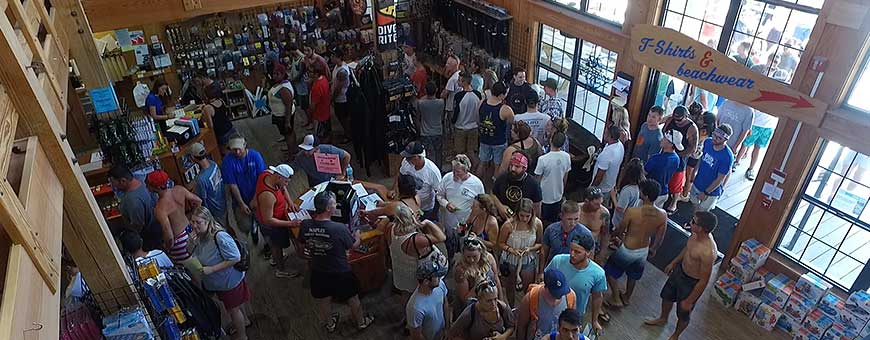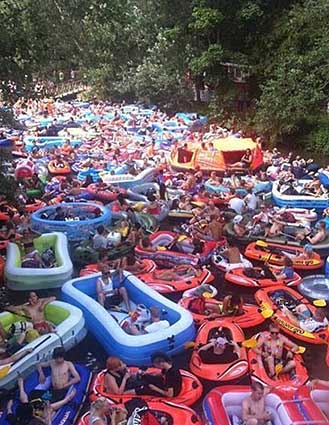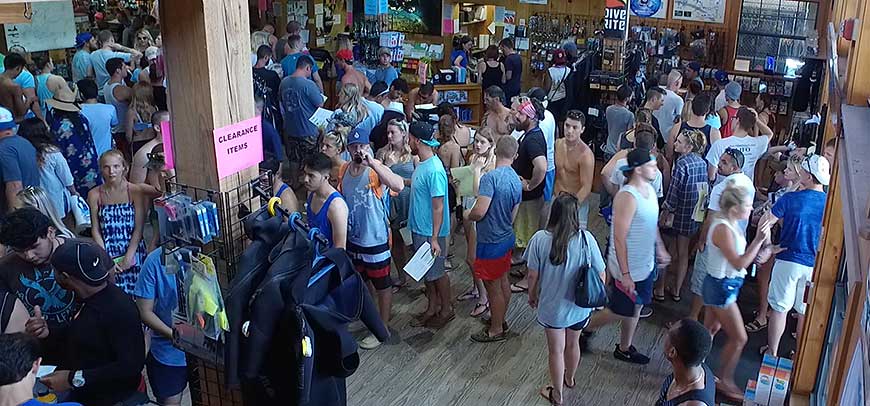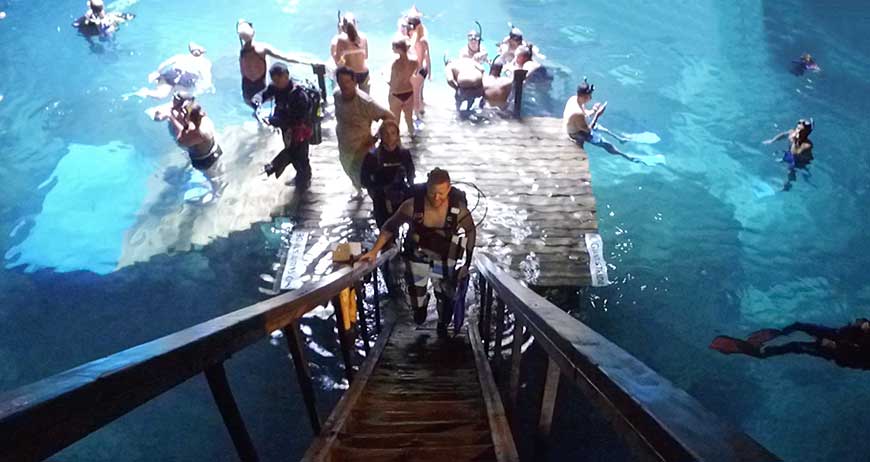What is the best strategy for cave diving in north-central Florida on busy summer weekends? Cave explorer Win Brown may have summed it up in one word: Don’t. Seriously, if you can limit your summertime cave diving to weekdays, you’ll be happier for it. Unfortunately, that’s not an option for many people.
If weekends are the only time you have available for diving, there are strategies you can follow that can make the experience a lot less aggravating. But to employ these strategies, you first need to fully understand the problem.

Too many people
Unlike the week between Christmas and New Year’s, the problem with summertime cave diving isn’t that there are too many divers in the cave, it’s that there are too many non-divers at the site.
- The staff at Ginnie Springs has a new catch phrase: Every weekend is Memorial Day. Memorial Day was always famous as the one weekend you’d want to avoid Ginnie at all costs. However, there have been several weekends since when Ginnie has actually been busier than Memorial Day. This can result in a wait of up to an hour or more to check in and, when you do get checked in, there can be little or no parking by the water and you may find the decks and stairs totally clogged by non-divers.

- Little River can be nearly as bad. While checking in is not an issue, the fact remains that, if you are not there before 9:00 (or, possibly, earlier) you may not find a parking place sufficiently close to the water.
- Devil’s Den is not a cave-diving site, but if you teach recreational scuba, it may be one of your go-to sites for open-water training dives. And while the Den once looked like a ghost town this time of year, in the past several months it has become a Mecca for snorkelers, who sometimes wait in line for as much as an hour and a half to get in the water. Devil’s Den still welcomes scuba divers and, especially, scuba classes (unlike the snorkeling clientele, scuba divers never have to wait to get in). Just be aware that, if you come to dive or teach, you are likely to find snorkelers constantly under foot, tying up everything from stairs to decks.
Basic strategies for avoiding…everyone
Regardless of where you dive, there are five basic strategies you can follow to keep from constantly finding swimmers, snorkelers and drunks under foot. These include:
 Stay home: Or, more specifically, stay closer to home. Odds are, unless you live here in north-central Florida, you have one or more local dive sites which are only diveable this time of year. Have you really seen all there is to see there? Bear in mind also that summer is a great time to be diving off shore, as there are many days when seas are dead calm or close to it.
Stay home: Or, more specifically, stay closer to home. Odds are, unless you live here in north-central Florida, you have one or more local dive sites which are only diveable this time of year. Have you really seen all there is to see there? Bear in mind also that summer is a great time to be diving off shore, as there are many days when seas are dead calm or close to it.
- Focus on diver-only sites: Remember that sites such as Peacock and Cow are only available to divers. You may run into fellow cave divers there; however, these present nowhere near the problem that 200 drunks and goobers can.
- Start earlier: This is not the time of year for sleeping in. No matter where you dive, get as early a start as possible. The sooner you get there, the fewer non-divers you will have to contend with.
- Be self-contained: The chief benefit in arriving early is often the fact you get a better parking spot. And, having secured one, you don’t want to give it up to some fool with a tube and a 12-pack. Pack a lunch and plenty of liquids. Keep in mind also that renting an extra set of tanks may be little more than the cost of a fill — especially when you factor in the time and gas it may take to gas up mid-day.
- Consider diving wet: At crowded sites, you can experience any number of delays trying to get into the water, as the clueless hordes simply don’t understand the importance of not blocking decks and stairs. If diving dry, this can lead to a potentially dangerous overheating situation. If you anticipate bottom times of less than an hour (and this can vary, depending on depth and your personal tolerance for cold), consider diving wet. You may also want to consider putting your wet suit on in the water or at least taking a quick dip to saturate your suit prior to donning tanks, harnesses, etc. This may reduce the risk of overheating.
Now let’s look at some strategies that apply to specific sites.
Madison Blue
The saving grace for Madison Blue is that there are no recreational divers allowed, few snorkelers…and no alcohol. If you can arrive right at 8:00 when the park opens, you generally have no difficulty getting a good parking spot. Just be prepared to see a lot more people when you surface from your dive.
Peacock
Among the best spots for summer cave diving, Peacock is visited almost exclusively by cave divers. Weekend parking is seldom a problem, any time of day. Perhaps the most important thing to bear in mind is the possibility of being visited by the Florida state bird (i.e., the mosquito). Pack bug spray. You may not need it; however, it’s better to have it and not need it than…
Cow Spring
This NSS-CDS-owned dive site is yet another excellent choice for summertime cave diving. You have to be an NSS-CDS member to dive it; however, you can sign up at Dive Outpost as the same time you fill out the site waiver. As with Peacock, bring bug spray.
Little River

Little River is the poster child for the importance of getting an early start on summer weekends. By mid-morning the parking lot can be completely full and you will not be able to get a parking spot anywhere close to the water. Fortunately, the park opens at 7:00, and being there at this time, or shortly thereafter, can help you escape the hordes. Also, if you do end up stuck far from the stairs, a wagon or hand truck will at least help you wheel your tanks to the water.
Ginnie Spring
When it comes to summer cave diving, Devil’s Eye and Ear were always the spot. The spot to avoid. If anything, that situation is worse than ever. Nevertheless, if you absolutely must dive Ginnie on a summer weekend, there are some things you can do to make it work. These include:
- Avoid the store before mid-afternoon: On weekends, it’s often packed from the time the doors open until after lunch.

- Get your car pass the day before: Stop by after 3:00 and pick up your pass for the next morning. This way you will not have to wait in line for an hour or more and you can bypass the store the next morning on your way in.
- Bring wheels: While your chances of parking at Turkey Roost on a weekend are slim, with a wagon or hand truck you can at least roll your tanks to Devil’s Eye and get in there. Doing so will not only save the gas you would otherwise consuming swimming the run, it helps you avoid the dismal visibility caused by careless tubers and snorkelers.
- Be at the water no later than 8:00: You’ll not only stand a better chance of getting a good parking space, you may discover you have the cave largely to yourself.
Manatee Spring
Manatee Spring’s Catfish Hotel is another viable summertime cave diving site — provided no teams have gotten there ahead of you. For reasons defying logic, Manatee limits the number of cave diving teams that can be in the cave at any given time. Best bet? Get there when the park opens. This will also help you get a better parking spot and avoid the non-divers who will show up in volume later on.
Devil’s Den
As you read earlier, this once ignored open-water training site is now overwhelmed by snorkelers every weekend. Your best bet is to:
- Reserve a “cabana” (pavilion) ahead of time.
- Arrive early.
 As we said, the stairs can be a problem when clogged by snorkelers, but they are supposed to give scuba divers the right of way. Having your students go up and down the stairs at one time will alleviate some of the problem. Just be aware that only one scuba diver at a time is to be on the stairs itself.
As we said, the stairs can be a problem when clogged by snorkelers, but they are supposed to give scuba divers the right of way. Having your students go up and down the stairs at one time will alleviate some of the problem. Just be aware that only one scuba diver at a time is to be on the stairs itself.
Blue Grotto
For teaching, Blue Grotto and be a mixed bag. On some summer weekends there can be a dozen or more instructors using the site; on other weekends it can be almost deserted. The good news is that you can call Kurt or Susan ahead of time to reserve one of the shelters for your group while at the same time finding out how many other groups are planning to be there.
What’s your take?
Bear in mind, this article reflects only my personal experience as an area resident and frequent cave diver. If you are also a regular visitor to north-central Florida’s cave country, you most likely have your own thoughts and suggestions on how to deal with the ever-burgeoning number of non-divers clogging our sites. Share them in the comments section below.
